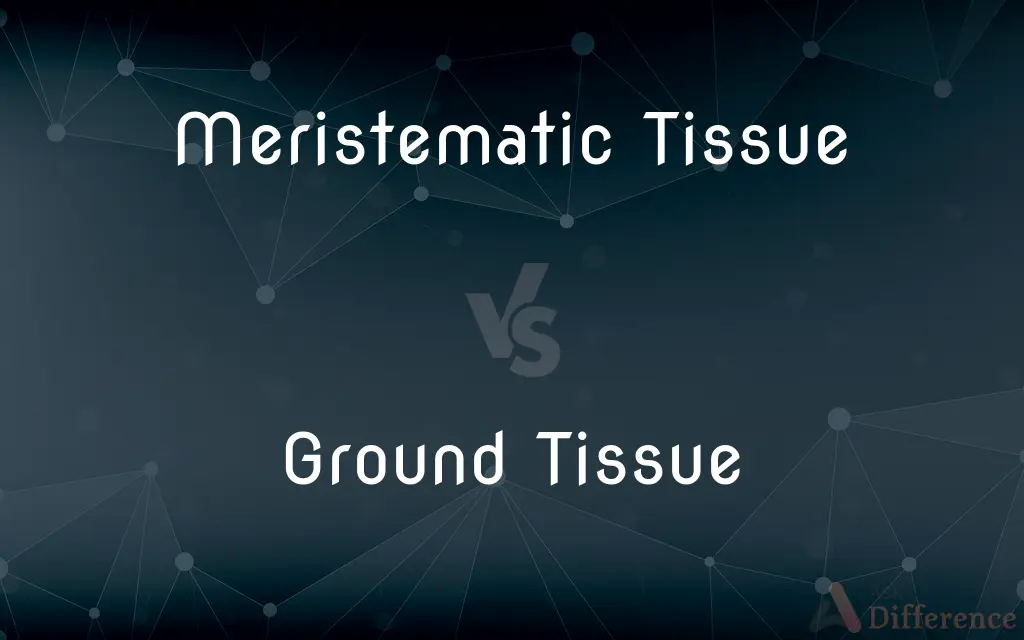Meristematic Tissue vs. Ground Tissue — What's the Difference?
By Tayyaba Rehman — Published on November 25, 2023
Meristematic Tissue enables plant growth through cell division; Ground Tissue fulfills fundamental functions like photosynthesis, storage, and support.

Difference Between Meristematic Tissue and Ground Tissue
Table of Contents
ADVERTISEMENT
Key Differences
Meristematic Tissue and Ground Tissue hold distinguished positions within plant anatomy, each playing pivotal roles in the structure and functionality of plants. Meristematic Tissue, embodied by its actively dividing cells, facilitates plant growth and development. Ground Tissue, on the other hand, broadly impacts various fundamental aspects of the plant, from photosynthesis to nutrient storage, providing support and ensuring sustenance.
A critical aspect of Meristematic Tissue lies in its perpetual capability for cell division, facilitating plants' growth in length (via apical meristem) and diameter (via lateral meristem). Contrarily, Ground Tissue is characterized by its multifunctionality in the plant body, providing not just physical support but also engaging in processes like photosynthesis and storage of nutrients, not contributing directly to plant growth.
Differentiating their locations, Meristematic Tissue is strategically positioned at regions of active growth like shoot and root tips. Ground Tissue, however, pervades throughout the plant, encapsulating other tissues and organs, and acting as a site for photosynthesis, storage, and support, occurring throughout the plant’s lifetime.
Their cellular structure also poses a notable distinction: Meristematic Tissue comprises undifferentiated or partially differentiated cells, ever-ready to divide and differentiate into varied cell types. Ground Tissue consists of more specialized cells that are typically differentiated to perform specific functions, such as parenchyma for photosynthesis and storage, or sclerenchyma for support.
Within their respective functionalities, Meristematic Tissue serves as the building block for all other tissues, ensuring the plant’s continuous growth and regeneration capability. Ground Tissue, meanwhile, provides the requisite physiological and mechanical support that maintains the plant’s structural integrity, safeguards the plant body, and ensures sustenance through its varied functional capabilities.
ADVERTISEMENT
Compare with Definitions
Meristematic Tissue
Meristematic Tissue comprises perpetually dividing cells.
Continuous cell division in Meristematic Tissue leads to the elongation of roots.
Ground Tissue
Ground Tissue provides support and stores nutrients in plants.
The potato tuber stores starch in its Ground Tissue.
Meristematic Tissue
Meristematic Tissue can differentiate into various cell types.
Meristematic Tissue at the shoot tip differentiates into leaf cells.
Ground Tissue
Ground Tissue partakes in the process of photosynthesis.
The cells of Ground Tissue in leaves facilitate photosynthesis.
Meristematic Tissue
Meristematic Tissue is located at sites of active growth.
Meristematic Tissue in the root tip facilitates its downward growth.
Ground Tissue
Ground Tissue can provide mechanical strength to plants.
Sclerenchyma, a type of Ground Tissue, fortifies the stem providing support.
Meristematic Tissue
Meristematic Tissue is responsible for plant growth.
The shoot tip contains Meristematic Tissue, enabling the plant to grow taller.
Ground Tissue
Ground Tissue encompasses various other tissues and spaces.
Ground Tissue surrounds vascular tissues, providing a protective layer.
Meristematic Tissue
Meristematic Tissue ensures regeneration in plants.
Damaged plants can regrow parts due to the activity of Meristematic Tissue.
Ground Tissue
Ground Tissue is found throughout the plant.
From roots to leaves, Ground Tissue offers functional uniformity across the plant.
Common Curiosities
What are the fundamental functions of Ground Tissue?
It is involved in photosynthesis, nutrient storage, and providing support to the plant.
Is Ground Tissue essential for plant growth?
No, it doesn’t directly facilitate growth but performs vital supporting functions.
Is Ground Tissue capable of cell division?
Generally, no. Ground Tissue cells are typically specialized and do not divide.
Can Meristematic Tissue differentiate into Ground Tissue?
Yes, Meristematic Tissue can differentiate into various tissues, including Ground Tissue.
How does Meristematic Tissue affect plant regeneration?
It facilitates regeneration by providing new cells that replace damaged ones.
What is the primary role of Meristematic Tissue?
It enables growth by continuously dividing and producing new cells.
Where can Meristematic Tissue be found?
At regions of active growth like root tips and shoot tips.
What ensures the continuity of plant growth despite damage?
The presence and activity of Meristematic Tissue ensure continuous growth.
Is Ground Tissue present in all plant organs?
Yes, it is commonly found across various plant organs, providing multiple functionalities.
What cells are typically present in Meristematic Tissue?
Undifferentiated or partially differentiated cells are characteristic of Meristematic Tissue.
What gives rise to primary and secondary growth in plants?
Apical Meristematic Tissue facilitates primary growth, while lateral meristems facilitate secondary growth.
Can Ground Tissue be involved in defense mechanisms?
Yes, certain cells in Ground Tissue may contribute to plant defense.
Can Ground Tissue participate in metabolic activities?
Yes, especially in processes like photosynthesis and nutrient storage.
How does Ground Tissue contribute to plant support?
It offers mechanical support via specialized cells like sclerenchyma.
Is it possible to have plants without Meristematic Tissue?
No, Meristematic Tissue is crucial for growth and development in plants.
Share Your Discovery

Previous Comparison
Rs vs. Re
Next Comparison
Rented House vs. Paying GuestAuthor Spotlight
Written by
Tayyaba RehmanTayyaba Rehman is a distinguished writer, currently serving as a primary contributor to askdifference.com. As a researcher in semantics and etymology, Tayyaba's passion for the complexity of languages and their distinctions has found a perfect home on the platform. Tayyaba delves into the intricacies of language, distinguishing between commonly confused words and phrases, thereby providing clarity for readers worldwide.
















































